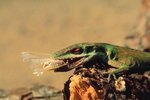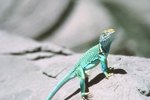Flying draco (or dragon) lizards live in Southeast Asia, where they can grow up to 8 inches long. They don’t actually fly but can glide up to 30 feet through the air, thanks to ribs that extend outward and skin membranes that serve as wings. They use this technique to travel between trees for mating, hunting and defense against both predators and interlopers.
Range
More than 40 species of draco lizards live throughout Southeast Asia, from southern India east to the Philippines and Indonesia. They spend most of their time in trees, favoring tropical rainforests and other wooded areas. They’re common across their range and aren’t considered threatened.
Environments
Draco lizards live in a variety of trees and apparently don’t prefer one type over others. Various draco species do specialize in different wooded habitats, though. For example, giant gliding lizards usually live near rivers, and five-banded gliding lizards favor areas with thick, dense growth. Black-bearded and dusky gliding lizards live in a wide array of forests at low elevations.
Territory
Usually, groups of one to three female draco lizards and a single male occupy two or three trees. Males are extremely territorial, gliding from one tree to another to confront interlopers. They defend their areas against other males through displays of intimidation and, if necessary, chase away the trespassers.
Inter-species Coexistence
Some draco species range over entire trees, from near the base to the tips of branches. Smaller dracos, such as the black-bearded gliding lizard, often have large wings in relation to their light body mass. As a result, they can launch easily from low on the trunk or branches and quickly gain altitude. Orange-bearded gliding lizards and other large dracos have less wingspan for their body mass and need to take off from higher on the tree, to compensate for an initial drop before they begin to glide. Because of their different elevation needs, species such as these two can live on the same trees or in close proximity to each other.
Activity
Flying draco lizards tend to be active through the morning and afternoon hours although, during the brightest parts of the day, the lizards seem to prefer remaining in shade, avoiding intense sunlight, high temperatures or both. They prey on ants and termites, either racing up and down in pursuit of food or choosing a spot, perching with their heads facing upward and grabbing any insects that approach.
Eggs
Draco lizards usually descend to the ground only to lay eggs. The female digs a hole with her snout, then lays a clutch of around five eggs. She packs the soil over them and remains on guard nearby for about 24 hours. Then she returns to her tree, and the eggs hatch around a month later.
References
- National Geographic: Animals: Draco Lizard
- University of Michigan Museum of Zoology: Animal Diversity Web: Draco volans -- Common Flying Dragon
- Map of Life: Convergent Evolution Online: Gliding in Draco Lizards and Tree Snakes
- Wild Asia: The Flying Reptiles of Tropical Asia: Evolution Takes a Leap (part 2): L. Lee Grismer
- Raffles Bulletin of Zoology: Natural History Observations of the Flying Lizard, Draco volans sumatranus (Agamidae, Squamata) from Sarawak, Malaysia (PDF): Akira Mori and Tsutomu Hikida





